[学习笔记] CS131 Computer Vision: Foundations and Applications:Lecture 9 深度学习
深度学习
So far this week
- Edge detection
- RANSAC
- SIFT
- K-Means
- Linear classifier
- Mean-shift
- PCA/Eigenfaces
- Image features
Current Research
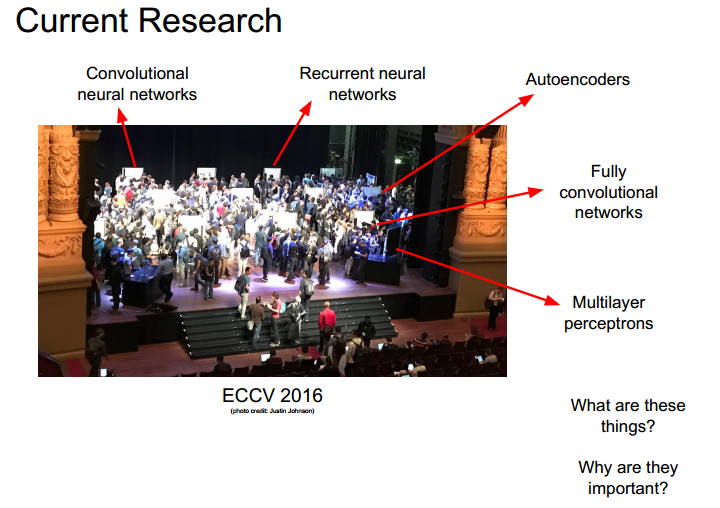
- Learning hierarchical representations from data
- End-to-end learning: raw inputs to predictions
- can use a small set of simple tools to solve many problems
- has led to rapid progress on many problems
- Inspired by the brain(very loosely!)
Deep learning for different problems
vision tasks
visual recognition

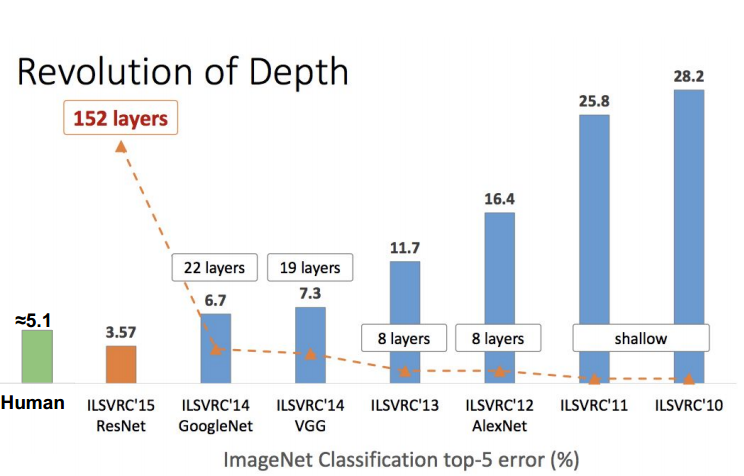
object detection: what and where

object segmentation
image caption
visual question answering
super resolution
image retrieval
style transfer
outside vision tasks
- Machine Translation
- Text Synthesis
- Speech Recognition
- Speech Synthesis
Motivation
Data-driven approach:
- collect a dataset of images and labels
- use machine learning to train an image calssifier
- evaluate the classifier on a withheld set of test images
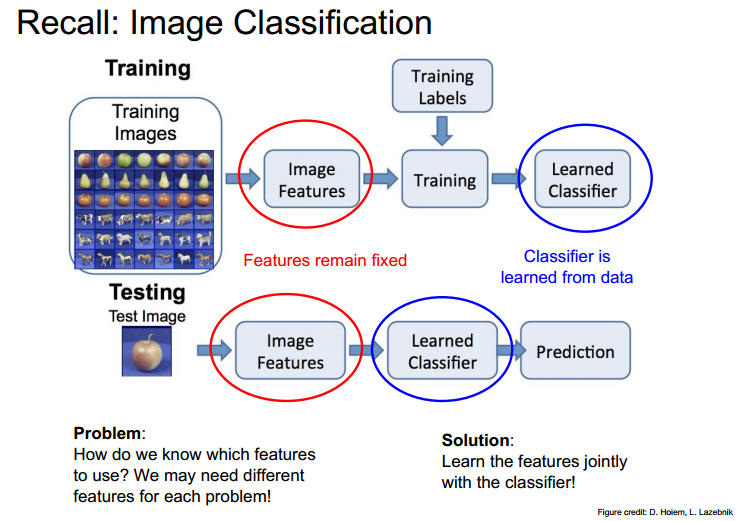
feature learning
what is feature learning?[^what is feature learning]
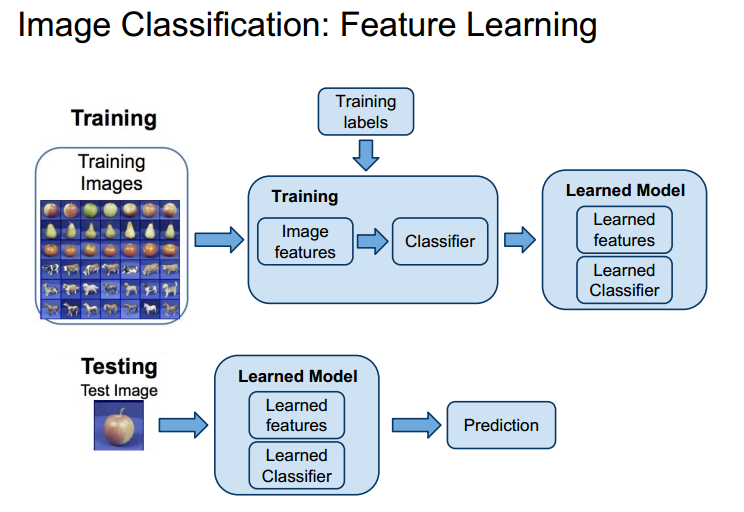
deep learning
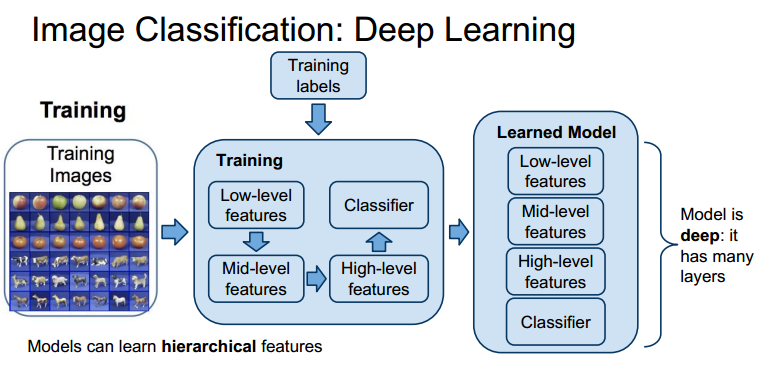
Supervised learning
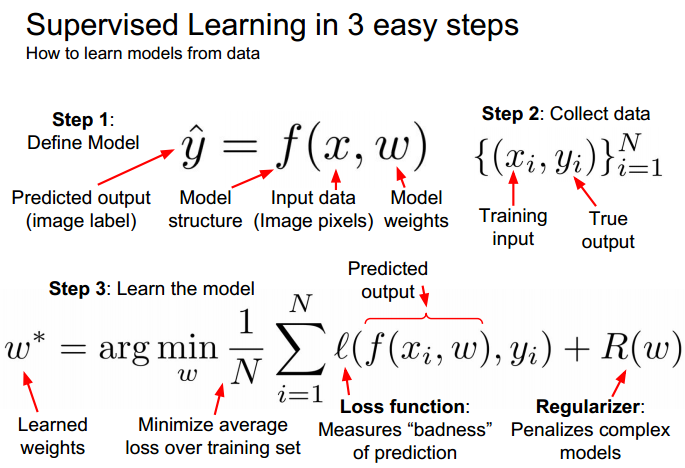
linear regression
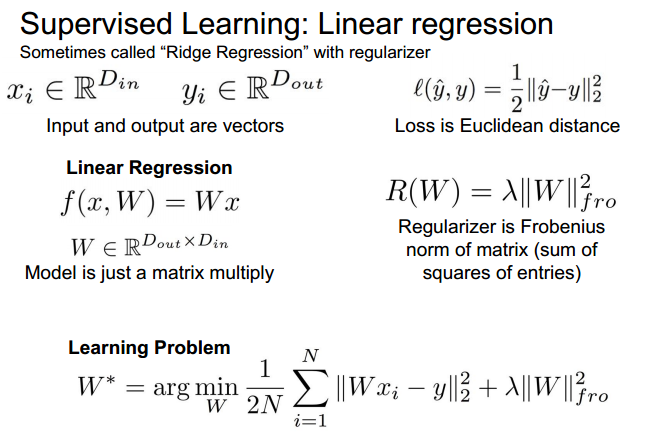
neural network
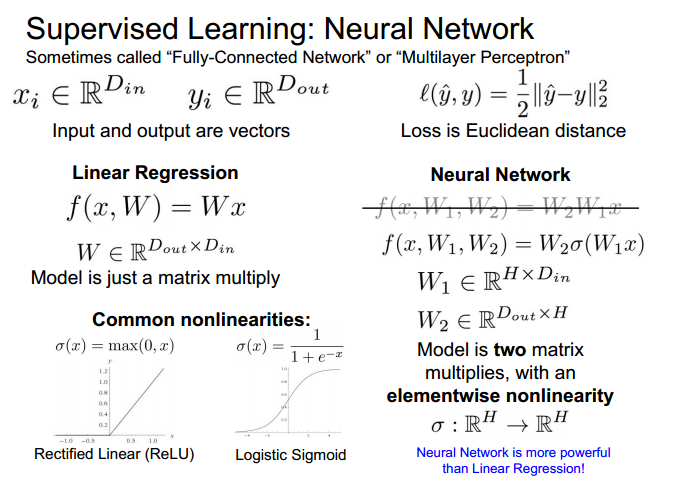
neural networks with many layers
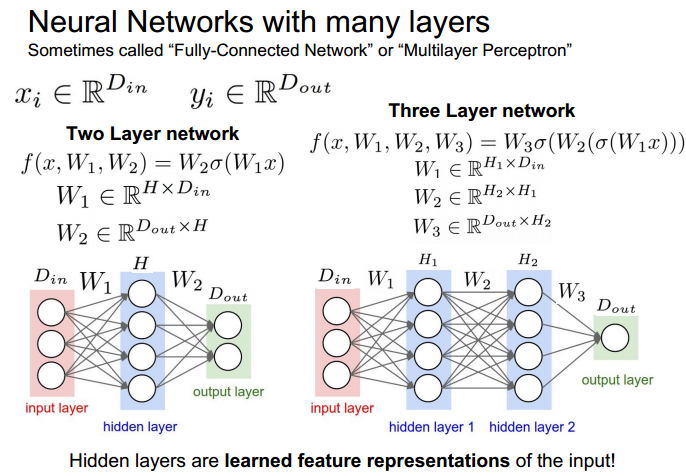
Gradient descent
how to find the best weights \(w^T\)
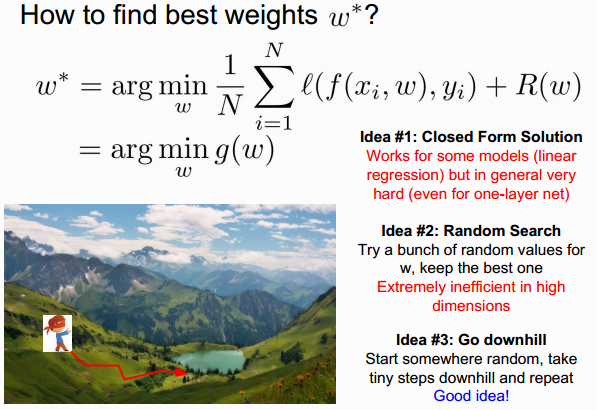
which way is down hill?

gradient descent
fancier rules:
- Momentum
- NAG
- Adagrad
- Adadelta
- Rmsprop
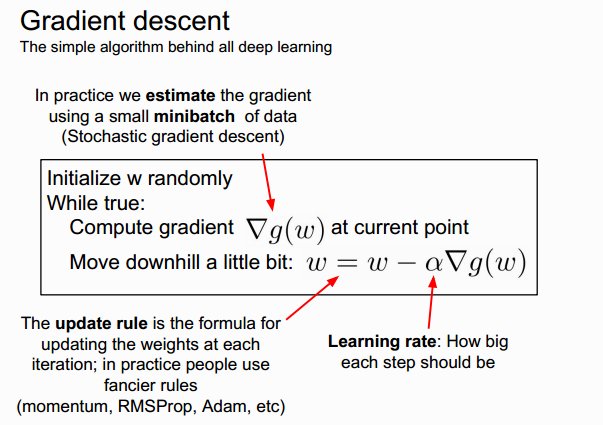
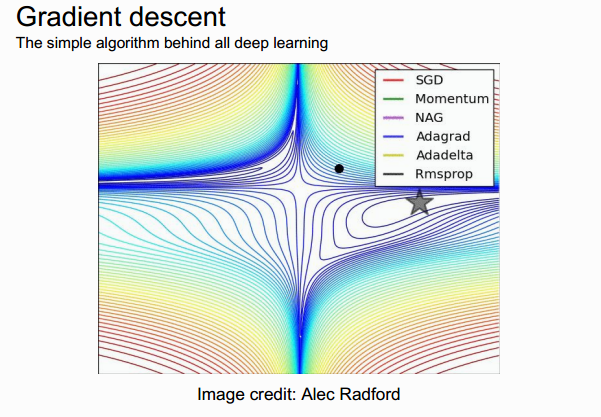
这里以后可以再 看看!
Backpropagation
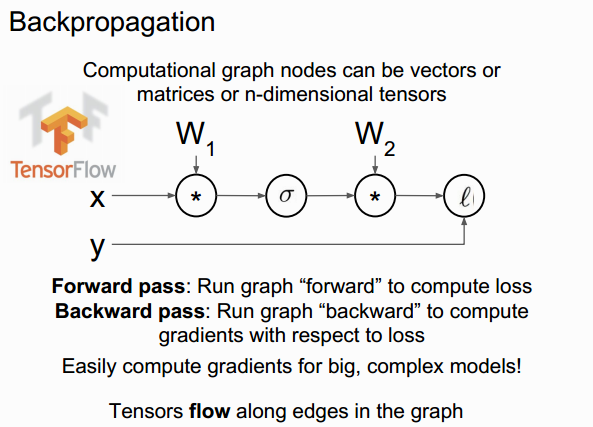
a two-layer neural network in 25 lines of code
import numpy as npD,H,N = 8, 64,32#randomly initialize weightsW1 = np.random.randn(D,H)W2 = np.random.randn(H,D)for t in xrange(10000):x = np.random.randn(N,D)y = np.sin(x)s = x.dot(W1)a = np.maxium(s,0)y_hat = a.dot(W2)loss = 0.5*np.sum((y_hat-y)**2.0)dy_hat = y_hat - ydW2 = a.T.dot(W2.T)da = dy_hat.dot(W2.T)ds = (s > 0)*dadW1 = x.T.dot(ds)W1 -= learning_rate*dW1W2 -= learning_rate*dW2
[^what is feature learning]:
In Machine Learning, feature learning or representation learningis a set of techniques that learn a feature: a transformation of raw data input to a representation that can be effectively exploited in machine learning tasks. This obviates manual feature engineering, which is otherwise necessary, and allows a machine to both learn at a specific task (using the features) and learn the features themselves.
Feature learning is motivated by the fact that machine learning tasks such as classification often require input that is mathematically and computationally convenient to process. However, real-world data such as images, video, and sensor measurement is usually complex, redundant, and highly variable. Thus, it is necessary to discover useful features or representations from raw data. Traditional hand-crafted features often require expensive human labor and often rely on expert knowledge. Also, they normally do not generalize well. This motivates the design of efficient feature learning techniques, to automate and generalize this.
Feature learning can be divided into two categories: supervised and unsupervised feature learning, analogous to these categories in machine learning generally.
In supervised feature learning, features are learned with labeled input data. Examples include Supervised Neural Networks, Multilayer Perceptron, and (supervised) dictionary Learning.
In unsupervised feature learning, features are learned with unlabeled input data. Examples include dictionary learning, independent component analysis, autoencoders, and various forms of clustering.
[学习笔记] CS131 Computer Vision: Foundations and Applications:Lecture 9 深度学习的更多相关文章
- [学习笔记] CS131 Computer Vision: Foundations and Applications:Lecture 1 课程介绍
课程大纲:http://vision.stanford.edu/teaching/cs131_fall1718/syllabus.html 课程定位: 课程交叉: what is (computer) ...
- [学习笔记] CS131 Computer Vision: Foundations and Applications:Lecture 2 颜色和数学基础
大纲 what is color? The result of interaction between physical light in the environment and our visual ...
- [学习笔记] CS131 Computer Vision: Foundations and Applications:Lecture 4 像素和滤波器
Background reading: Forsyth and Ponce, Computer Vision Chapter 7 Image sampling and quantization Typ ...
- [学习笔记] CS131 Computer Vision: Foundations and Applications:Lecture 3 线性代数初步
向量和矩阵 什么是矩阵/向量? Vectors and matrix are just collections of ordered numbers that represent something: ...
- Computer Vision: Algorithms and ApplicationsのImage processing
实在是太喜欢Richard Szeliski的这本书了.每一章节(after chapter3)都详述了该研究方向比較新的成果.还有很多很多的reference,假设你感兴趣.全然能够看那些參考论文 ...
- Deep Learning 10_深度学习UFLDL教程:Convolution and Pooling_exercise(斯坦福大学深度学习教程)
前言 理论知识:UFLDL教程和http://www.cnblogs.com/tornadomeet/archive/2013/04/09/3009830.html 实验环境:win7, matlab ...
- Sony深度学习框架 - Neural Network Console - 教程(1)- 原来深度学习可以如此简单
“什么情况!?居然不是黑色背景+白色文字的命令行.对,今天要介绍的是一个拥有白嫩的用户界面的深度学习框架.” 人工智能.神经网络.深度学习,这些概念近年已经涌入每个人的生活中,我想很多人早就按捺不住想 ...
- 百度DMLC分布式深度机器学习开源项目(简称“深盟”)上线了如xgboost(速度快效果好的Boosting模型)、CXXNET(极致的C++深度学习库)、Minerva(高效灵活的并行深度学习引擎)以及Parameter Server(一小时训练600T数据)等产品,在语音识别、OCR识别、人脸识别以及计算效率提升上发布了多个成熟产品。
百度为何开源深度机器学习平台? 有一系列领先优势的百度却选择开源其深度机器学习平台,为何交底自己的核心技术?深思之下,却是在面对业界无奈时的远见之举. 5月20日,百度在github上开源了其 ...
- Python入门学习笔记4:他人的博客及他人的学习思路
看其他人的学习笔记,可以保证自己不走弯路.并且一举两得,即学知识又学方法! 廖雪峰:https://www.liaoxuefeng.com/wiki/0014316089557264a6b348958 ...
随机推荐
- HDU 4704 Sum( 费马小定理 + 快速幂 )
链接:传送门 题意:求 N 的拆分数 思路: 吐嘈:求一个数 N 的拆分方案数,但是这个拆分方案十分 cd ,例如:4 = 4 , 4 = 1 + 3 , 4 = 3 + 1 , 4 = 2 + 2 ...
- -1 深度学习基础caffe
一.反思 二.反向传播 三.ubuntu安装caffe 四.追踪关键词
- linux 编译网卡驱动
将smsc7500网卡驱动拷贝到/drive/net/usb文件夹下 拷贝ioctl_7500.h smsc7500usbnet.c smsc7500version.h smsclan7500.h ...
- vue 如何动态切换组件,使用is进行切换
日常项目中需要动态去切换组件进行页面展示. 例如:登陆用户是“管理员”或者“普通用户”,需要根据登陆的用户角色切换页面展示的内容.则需要使用 :is 属性进行绑定切换 <template> ...
- hdu 2435dinic算法模板+最小割性质
hdu2435最大流最小割 2014-03-22 我来说两句 来源:hdu2435最大流最小割 收藏 我要投稿 2435 There is a war 题意: 给你一个有向图,其中可以有一条边是无敌的 ...
- HDU 1215
由算术基本定理, 直接使用公式就好 #include <iostream> #include <cstdio> #include <algorithm> #incl ...
- Flash的选择
算起来自己接触Flash接近4年了. 最開始的2.0,做button,做动画,做导航. 后来用3.0做动画,做相冊.做毕业设计,做课件. 然后到公司做2.0的动画,模板开发,效果设计. 似乎又回到了原 ...
- tableView计算动态行高的总结
研究tableView怎么计算动态行高研究了两天一直还不太会,今天最终做出来了想要的效果. 首先.我在网上搜集了非常多资料,各种大神的总结,然后開始看.研究.试验,基本思路都是一样的. 1.一定要将l ...
- hdu 4037 Development Value(线段树维护数学公式)
Development Value Time Limit: 5000/3000 MS (Java/Others) Memory Limit: 65768/65768 K (Java/Others ...
- node-webkit 屏幕截图功能
做 IM 屏幕截图是少不了的,之前 windows 版本是调用的 qq 输入法的截图功能,这个版本又再次尝试自己实现发现是可以的,getusermedia 的权限很高,代码如下 <!DOCTYP ...
